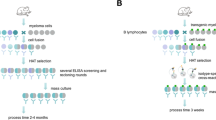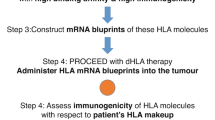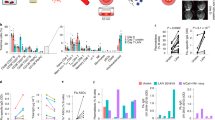Abstract
THE use of a hybrid between Ehrlich ascites tumour and hamster cell lines to immunize mice against the tumour has been reported1. We report here the use for the same purpose of a hybrid line between Ehrlich ascites tumour cells and cells derived from mouse embryo cells obtained from an inbred strain of mice (CBA). This hybrid is less immunologically foreign than the hamster × Ehrlich hybrid for the randomly bred Swiss mice used in the immunization experiments; it differs antigenically only in histocompatibility antigens, in particular in its H2 antigen, which, for CBA mice, is the H2k antigen. Such a hybrid gave the opportunity of investigating whether the immunity arising after injection of Ehrlich × hamster hybrids1 was the result of strong histocompatibility antigens (of H2 type) in the Ehrlich cells.
This is a preview of subscription content, access via your institution
Access options
Subscribe to this journal
Receive 51 print issues and online access
$199.00 per year
only $3.90 per issue
Buy this article
- Purchase on Springer Link
- Instant access to full article PDF
Prices may be subject to local taxes which are calculated during checkout
Similar content being viewed by others
References
Watkins, J. F., and Chen, L., Nature, 223, 1018 (1969).
Harris, H., Watkins, J. F., Ford, C. E., and Schoefl, G. I., J. Cell Sci., 1, 1 (1966).
Author information
Authors and Affiliations
Rights and permissions
About this article
Cite this article
CHEN, L., WATKINS, J. Evidence against the Presence of H2 Histocompatibility Antigens in Ehrlich Ascites Tumour Cells. Nature 225, 734–735 (1970). https://doi.org/10.1038/225734a0
Received:
Issue Date:
DOI: https://doi.org/10.1038/225734a0
This article is cited by
-
A tumor-associated heparan sulfate-related glycosaminoglycan promotes the generation of functional regulatory T cells
Cellular & Molecular Immunology (2023)
-
Antioxidant, cytotoxic and apoptotic activities of the rhizome of Zingiber zerumbet Linn. in Ehrlich ascites carcinoma bearing Swiss albino mice
Scientific Reports (2022)
-
Indole glucosinolates exhibit anti-inflammatory effects on Ehrlich ascites carcinoma cells through modulation of inflammatory markers and miRNAs
Molecular Biology Reports (2021)
-
Daunorubicin conjugated with alpha-fetoprotein selectively eliminates myeloid-derived suppressor cells (MDSCs) and inhibits experimental tumor growth
Cancer Immunology, Immunotherapy (2018)
-
Solanum tuberosum lectin inhibits Ehrlich ascites carcinoma cells growth by inducing apoptosis and G2/M cell cycle arrest
Tumor Biology (2016)
Comments
By submitting a comment you agree to abide by our Terms and Community Guidelines. If you find something abusive or that does not comply with our terms or guidelines please flag it as inappropriate.



